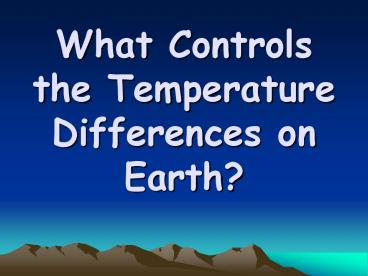What Controls the Temperature Differences on Earth? PowerPoint PPT Presentation
1 / 12
Title: What Controls the Temperature Differences on Earth?
1
What Controls the Temperature Differences on
Earth?
2
Factors that Affect Global Temperature Differences
- Latitude
- Topography
- Proximity to Water
- Large Cities
3
Latitude
- Different areas on the Earth receive different
amount of solar radiation due to the Earths
tilt. - Equatorial latitudes receive the most radiation
- Polar latitudes receive the least
4
Latitude (contd.)
- Reason for the Seasons
- Dec-Feb N-hemisphere points away from sun
- Jun-Aug N-hemisphere points towards sun
- Equator always gets more direct and intense solar
radiation
5
Latitude (contd.)
- Global wind patterns (aka Hadley cells)
- Air is heated over the equator more than at the
poles. - Differential heating causes the warm, low density
air to rise - Air sinks at 30 and 90 latitude.
- Colors indicate air temperatures
- Large arrows indicate wind direction
6
Latitudinal Zones
- Tropics
- between 23.5?N 23.5?S
- hot temperatures, humid
- Trade Winds blow from east to west, toward the
equator - Polar Zones
- from 90 to 66.5?N S latitudes
- cold temperatures and dry
- Polar Easterlies blow from east to west, away
from the poles - Temperate Zones
- between the tropics polar zones
- moderate temperatures
- Can be humid or dry
- Westerlies blow from west to east
7
Topography
- Within each climate zone, topographic features
affect the climate. - Structure of the Atmosphere
- Increase in altitude --gt colder, dryer fewer
molecules to absorb solar radiation
8
Topography Orographic Effect
- Windward Side of Mountains
- air rises, cools, and forms precipitation
- Leeward Side of Mountains
- air descends, heats up, and dries out the land
- rain-shadow deserts
9
Large Bodies of Water
- Higher moisture availability
- Temperatures are more moderate
- Coastal areas are warmer in the winter and cooler
in the summer
10
Large Bodies of Water (contd)
- Sea Breezes
- Air moves from cool to warm
- Daytime from sea to land
- Night time from land to sea
- Effect of moderating areas temperature and
raises the humidity
11
Large Bodies of Water (contd)
- Ocean Currents
- Cold currents cool air
- Warm currents warm air
- Air temperatures over land are directly effected
by temperature of ocean current
12
Large Cities
- Summer temperatures can be 5?C warmer.
- Streets, parking lots, and buildings absorb solar
radiation. - Absorbed solar radiation is then re-radiated back
into the atmosphere as heat. - Pollution traps heat.

